Towing Safety Advisory Committee
-
- AWO Working Hard for the Domestic Workboat Market Maritime Reporter, Aug 2015 #22
The year 2015 has been a busy year for The American Waterways Operators, the national trade association for the tugboat, towboat and barge industry, and for the industry AWO is privileged to represent. It’s a dynamic time for a vital industry that constitutes the largest segment of the U.S. domestic fleet, as companies throughout the industry are investing heavily to meet evolving customer needs; the industry stands on the verge of historic regulatory change; and AWO pursues an active public policy agenda to support members’ needs for predictable and practicable government policy.
Investing for the Future
The tugboat, towboat and barge industry is a critical part of our nation’s transportation system. Each year, the industry’s 5,000 tugboats and towboats and 23,000 barges move more than 800 million tons of critical commodities that are the building blocks of the U.S. economy, including petroleum, coal, chemicals, stone, sand, gravel, cement, steel and lumber. The industry employs more than 33,000 Americans as vessel crew members and nearly half a million Americans work in industries that rely upon water transportation.
AWO members are investing heavily to meet the demands of their customers and our country for safe, reliable, cost-effective transportation. In 2014, there were a record 344 new tank barges delivered with a total capacity of 7.74 million barrels. Investment in dry cargo capacity is occurring as well, with 561 inland hopper barges delivered last year, a five percent increase from the 2013 levels. Some 117 new tugboats and towboats were constructed in 2014, and 10 state-of-the-art articulated tug-barge units (ATBs) will be delivered within the next two years.
A New Safety Paradigm: Towing Vessel Inspection
This year, the tugboat, towboat and barge industry is on the verge of an historic regulatory advancement, anticipating the publication of new U.S. Coast Guard regulations that will bring towing vessels under an innovative inspection regime that will improve safety, security and environmental stewardship throughout the industry. Securing the publication of and preparing AWO’s members to comply with the new regulations—known as Subchapter M—are AWO’s highest advocacy and safety priorities.
For more than a decade, AWO and its members have worked closely with the Coast Guard to develop Subchapter M, which is currently undergoing final review by the Department of Homeland Security. The Coast Guard, with the strong support of AWO, was directed by Congress to establish a towing vessel inspection regime in the Coast Guard and Maritime Transportation Act of 2004. Since that time, the Coast Guard has engaged stakeholders in an inclusive and thoughtful process to develop the rule via the Congressionally authorized Towing Safety Advisory Committee. The result is overwhelming support from the tugboat, towboat and barge industry, the public, and bipartisan members of Congress for finalizing the regulations.
When published, Subchapter M will build on the safeguards that responsible companies have already put in place and ensure that all towing vessels meet a minimum threshold of safety to protect life, the environment, and property. There will be two ways in which companies can comply with Subchapter M. The first is to submit to annual vessel inspections conducted by the Coast Guard. The second is to implement a Towing Safety Management System, or TSMS, that is accepted by the Coast Guard and audited by a Coast Guard-approved third party organization.
Since the start of the regulatory development process, AWO and TSAC have strongly supported making compliance with a safety management system a requirement of the new towing vessel inspection regulations. Safety management systems promote continuous regulatory compliance, provide early warnings of problems or deficiencies that could lead to accidents, and prevent accidents caused by equipment failure by ensuring continuous attention to routine vessel maintenance. Choosing to comply with Subchapter M by implementing a TSMS will also provide towing vessel operators with much greater flexibility, and will be a more efficient utilization of Coast Guard resources than annual Coast Guard inspections.
AWO members are already required to comply with a third-party-audited safety management system as a condition of membership in the association. In 1994, AWO became the first transportation trade association to adopt a code of safe practice and environmental stewardship for its member companies. Today, the AWO Responsible Carrier Program is the most widely used safety management system in the tugboat, towboat and barge industry. AWO members use the RCP to develop company-specific safety and environmental policies and programs tailored to the industry’s unique operational environments. The RCP incorporates best industry practices in company management policies, vessel equipment and human factors.
Earlier this year, the U.S. Coast Guard confirmed that it intends to accept the AWO Responsible Carrier Program as a TSMS once the towing vessel inspection regulations are finalized, concluding that the RCP is substantively equivalent to the International Safety Management Code.
AWO has high expectations that Subchapter M will have a transformative effect on industry safety by raising standards of safety and environmental stewardship throughout the tugboat, towboat and barge industry. That will be good for our industry, good for the environment, and good for the American public.
Moving Closer: Uniform Standards for Vessel Discharges
Another of AWO’s long-term advocacy priorities is moving closer to reality this year. For the last seven years, AWO and a broad coalition of over 60 national and regional maritime and business organizations have been pushing for legislative reform that would establish a uniform national framework for the regulation of ballast water and other vessel discharges. Through the bipartisan efforts of Sens. Marco Rubio (R-FL), John Thune (R-SD), and Bill Nelson (D-FL) S.373, the Vessel Incidental Discharge Act (VIDA), is poised to make its way to the Senate floor sometime after the August recess. The bill, which currently has 26 bipartisan cosponsors, was attached to the Coast Guard reauthorization bill (S. 1611) that was approved by the Senate Commerce Committee in June.
VIDA would end an untenable situation in which vessel operators must comply with both Coast Guard and Environmental Protection Agency regulations, as well as more than 150 state-specific requirements set by more than two dozen states. As AWO Vice Chairman James Farley, President of Kirby Offshore Marine, explained at a Senate Commerce Committee hearing in February, “The problem is not that vessel discharges are regulated; it is how they are regulated. The current unclear and inconsistent regulatory system makes compliance confusing and investment decisions uncertain.” VIDA will ensure the highest standard of protection for the waterways and provide the regulatory certainty vessel owners need to make investments in state-of-the-art ballast water treatment systems.
Companion legislation—H.R. 980—was introduced in the House by Representatives Duncan Hunter (R-CA), Elijah Cummings (D-MD) and Frank LoBiondo (R-NJ) and has 20 bipartisan cosponsors.
Building Support for the Jones Act
The tugboat, towboat and barge industry brings vital commodities to communities throughout the U.S. mainland, Alaska, Hawaii, and Puerto Rico. The industry also provides jobs for American citizens and supports U.S. economic, national and homeland security objectives, serving as the “eyes and ears” for the Coast Guard on the coastal and inland waterways. The statutory foundation of the domestic maritime industry is the Jones Act, which requires that vessels moving goods between U.S. ports be owned, crewed, and built by Americans.
The Jones Act provides a level playing field and a stable investment climate that gives American vessel owners the confidence to make long-term investments in vessels, equipment and shoreside infrastructure. With the Jones Act as its foundation, the domestic maritime industry supports nearly half a million American jobs and drives almost $100 billion in economic benefit to the United States.
Working closely with the American Maritime Partnership, a broad-based coalition of maritime and national defense organizations, AWO continually works o educate policymakers on the benefits the Jones Act provides brings to the country, working families, and communities that depend upon goods delivered safely, securely and efficiently. AWO and AMP also work to combat misinformation about the Jones Act and defeat attempts to weaken the law.
One such attempt arose just after the 114th Congress convened in January, when Sen. John McCain (R-AZ) filed an amendment to the Keystone XL Pipeline bill to repeal the U.S.-build requirement of the Jones Act. AWO joined AMP in an intensive lobbying effort to build opposition to the amendment, which was ultimately not offered during floor debate.
Significantly, senior U.S. military officials spoke out strongly in favor of the Jones Act and in opposition to the McCain amendment.
U.S. Coast Guard Commandant ADM Paul Zukunft questioned the effects of weakening the Jones Act on maritime safety and environmental protection on U.S. waterways, saying, “If we have foreign-flag vessels doing [coastal] trade, what are the safety standards, what are the maritime pollution standards? How are they in compliance with the same standards that we apply to our U.S. fleet?” General Paul Selva, then Commander of the U.S. Transportation Command and now Vice Chairman of the Joint Chiefs of Staff, told the Senate Armed Services Committee that “The Jones Act contributes to a robust domestic maritime industry that helps to maintain the U.S. industrial shipyard base and infrastructure to build, repair, and overhaul U.S. vessels. The Jones Act requirement for U.S.-crewed and built vessels provides additional capacity and trained U.S. merchant mariners that can crew RRF vessels in times of war or national emergency.”
Maintaining Waterways Reliability and Invasive Species Management
The introduction of invasive species such as Asian carp into the interdependent inland waterways system has created tension between the dual imperatives of controlling the movement of harmful fish and maintain the uninterrupted flow of commercial navigation. Unfortunately, efforts to control invasive species include proposals that would shut down segments of the waterways system.
This issue is particularly acute in Illinois, where the Chicago Area Waterways System (CAWS) is the sole link between the Mississippi River and the Great Lakes. Every year, barges safely and efficiently carry almost 20 million tons of cargo through the CAWS, including critical commodities such as grain and petroleum. However, initiatives to stop the spread of invasive species, including Asian carp, have the potential to disrupt vital transportation links. AWO is committed to working with government and private sector stakeholders to develop solutions that keep the waterways open for safe and efficient navigation while protecting against the spread of invasive species.
Conclusion
This is a dynamic time for the tugboat, towboat and barge industry, a vital industry pursuing an ambitious public policy agenda aimed at safeguarding and expanding its ability to provide safe, efficient, cost-effective transportation for the benefit of its customers and our country. AWO is committed to leading the industry in securing informed public policy that supports its members in moving vital cargoes, making investments in new vessels and equipment, and leading the transportation industry in safety and environmental stewardship.
The Author
Jennifer A. Carpenter serves as Executive Vice President of the American Waterways Operators (AWO), the national trade association representing the U.S. tugboat, towboat, and barge industry.
Ms. Carpenter joined AWO in August 1990. She served as Government Affairs Assistant, Manager-Regulatory Issues, Director-Government Affairs, Vice President-Government Affairs, Senior Vice President-Government Affairs and Policy Analysis, and Senior Vice President-National Advocacy before assuming her current position in December 2013. From 1994 to 2007, she was a member of the congressionally authorized Towing Safety Advisory Committee (TSAC). Ms. Carpenter has also served on the Committee on Inland Water Transportation of the National Research Council’s Transportation Research Board. She has received two Meritorious Public Service Awards and a Public Service Commendation from the U.S. Coast Guard for her contributions to the Towing Safety Advisory Committee and the Coast Guard-AWO Safety Partnership.
(As published in the August 2015 edition of Maritime Reporter & Engineering News - http://magazines.marinelink.com/Magazines/MaritimeReporter)
-
- AWO Regulatory Activity: A Review Of Problems — And Solutions — Currently Afloat Maritime Reporter, Aug 1984 #27
Waterways Operators, Inc. is the only association in the United States which focuses on the regulatory interests of the coastal and inland barge and towing industry. Through its committee structure, AWO carefully monitors all regulatory proposals dealing with the operation of vessels and waterways
-
- By the Numbers: Subchapter M Statistics Marine News, May 2013 #8
time.” Data, in part derived from estimates put together for the Coast Guard themselves, from the American Bureau of Shipping Group and the Towing Safety Advisory Committee (TSAC), and based upon the NPRM, is illuminating. The cost of a Safety Management System, assuming that it is not already in place,
-
- AWO Elects Officers For 1986 At Annual Convention In Washington Maritime Reporter, Jun 1986 #11
Port Bureau, past chairman of the AWO Tank Barge Conference, and past chairman of the AWO Southern Region. He has been involved in the barge and towing industry for 18 years. As AWO chairman of the board, Mr. Lawrence succeeds James H. Sanborn, vice president-operations, Sonat Marine, Inc., Philadelphi
-
- AWO Elects Creelman Chairman Of The Board Maritime Reporter, Aug 1984 #9
bulk liquids on the inland waterway system. Prior to his election as AWO Chairman, Mr. Creelman had been serving as vice chairman of the Coast Guard's Towing Safety Advisory Committee. Throughout his maritime career, he has served in leadership positions including membership on such panels as the Coast
-
- Insights: Pat Folan, Tug & Barge Solutions Marine News, Mar 2018 #14
in Erie Canal towing. He holds a Master of Towing Vessels for Near Coastal, Inland and Western Rivers. He was a member of the USCG’s Towing Safety Advisory Committee (TSAC) and a sub-committee chair for the Steel Hull Repair and Operational Stability tasks. A certified ISO 9001:2008 Lead Auditor, ISO
-
- Insights: Jennifer Carpenter, AWO President & CEO Marine News, Feb 2020 #12
, Senior Vice President-National Advocacy, and Executive Vice President. She served for 13 years as a member of the congressionally authorized Towing Safety Advisory Committee. She has received two Meritorious Public Service Awards and a Public Service Commendation from the U.S. Coast Guard for her contributions
-
- It's Time for a Towing Vessel Inspection Rule Marine News, Oct 2013 #17
rulemaking, and many of those comments echo very similar themes. There is a nine-year history of work by the congressionally authorized Towing Safety Advisory Committee and a strong public docket filled with the technical information the Coast Guard needs to finalize this rulemaking. The regulated community
-
- Reducing Human Error & Near Miss Incidents Marine News, Oct 2014 #8
, Offshore Marine Service Association (OMSA), the Passenger Vessel Association (PVA), the Ship Operations Cooperative Program (SOCP); and the Towing Safety Advisory Committee (TSAC). And, in the end, they examined spill causes by accident, type of vessel, service, size of vessel and myriad other variables. It’s
-
- The Legal Consequences of 46 CFR Subchapter “M” Maritime Reporter, Nov 2014 #20
more stringent regulation of uninspected towing vessels (UTVs). Since that time, the Coast Guard and several industry groups (including the Towing Safety Advisory Committee (TSAC), American Waterways Operators (AWO) and the American Bureau of Shipping) have been working hard to finalize the rulemaking and
-
- 2015: An Action Year for Subchapter M Marine News, Apr 2015 #22
way, and we urge the agency to take the same approach to the development of implementation policy guidance. The Congressionally authorized Towing Safety Advisory Committee (TSAC), which has already offered recommendations to the Coast Guard on manning levels and hull inspection and repair standards, is perfectly
-
- A New Approach To Issue Advocacy Maritime Reporter, Mar 1991 #21
today, and where improvements might be made in the future. Within this exercise are issues which have long been considered inviolate within the towing industry, and the willingness to look inward is an important measure of the industry's character. The magnitude of the effort alone is unprecedented
-
 )
March 2024 - Marine Technology Reporter page: 40
)
March 2024 - Marine Technology Reporter page: 40NEW TECH OCEANOLOGY INTERNATIONAL 2024 All photos courtesy MTR unless otherwise noted NEW TECH, PARTNERSHIPS LAUNCH IN LONDON With Oceanology International now one month in the rear-view mirror, MTR takes a look at some of the interesting technologies launched before, during and after the London event.
-
 )
March 2024 - Marine Technology Reporter page: 38
)
March 2024 - Marine Technology Reporter page: 38LANDER LAB #10 Photo courtesy West Mountain Radio Photo courtesy of Clarios/AutoBatteries.com Figure 6 The West Mountain Radio Computerized Battery Analyzer (CBA V) attaches to a Figure 5 laptop by a USB-B cable, and to a battery by Powerpole® Connectors. Exploded view of an AGM lead-acid battery.
-
 )
March 2024 - Marine Technology Reporter page: 25
)
March 2024 - Marine Technology Reporter page: 25Auerbach explained that ideally, “one ? ed layers of geothermal activity,” noted changes over an area of 8,000 km2. They would have both instruments: seismom- Skett, “and the change in salinity and dis- found up to seven km3 of displaced ma- eters to detect and locate subsurface ac- solved particles for
-
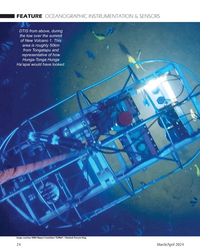 )
March 2024 - Marine Technology Reporter page: 24
)
March 2024 - Marine Technology Reporter page: 24FEATURE OCEANOGRAPHIC INSTRUMENTATION & SENSORS DTIS from above, during the tow over the summit of New Volcano 1. This area is roughly 50km from Tongatapu and representative of how Hunga-Tonga Hunga Ha’apai would have looked. Image courtesy NIWA-Nippon Foundation TESMaP / Rebekah Parsons-King 24
-
 )
March 2024 - Marine Technology Reporter page: 11
)
March 2024 - Marine Technology Reporter page: 11assist in identifying mines and act as a neutralization device. About the Author Bottom mines pose even greater chal- David R. Strachan is a defense analyst and founder of lenges. Unlike contact mines, bottom Strikepod Systems, a research and strategic advisory mines utilize a range of sensors to
-
 )
March 2024 - Marine Technology Reporter page: 6
)
March 2024 - Marine Technology Reporter page: 6MTR Editorial Advisors Gallaudet Hardy The Honorable Tim Gallaudet, Kevin Hardy is President PhD, Rear Admiral, U.S. of Global Ocean Design, Navy (ret) is the CEO of creating components and Ocean STL Consulting and subsystems for unmanned host of The American Blue vehicles, following a career
-
 )
April 2024 - Maritime Reporter and Engineering News page: 43
)
April 2024 - Maritime Reporter and Engineering News page: 43“The industry is an ecosystem which includes owners, managers, mariners, shipyards, equipment makers, designers, research institutes and class societies: all of them are crucial,” – Eero Lehtovaara, Head of Regulatory & Public Affairs, ABB Marine & Ports All images courtesy ABB Marine and Ports provi
-
 )
April 2024 - Maritime Reporter and Engineering News page: 42
)
April 2024 - Maritime Reporter and Engineering News page: 42OPINION: The Final Word Seeing the Ship as a System Shipping must engage with the decarbonization realities that lie ahead by changing the way it crafts maritime legislation to re? ect its place in the interconnected, interdependent world economy, said Eero Lehtovaara, ABB Marine & Ports. ABB Marine &
-
 )
April 2024 - Maritime Reporter and Engineering News page: 41
)
April 2024 - Maritime Reporter and Engineering News page: 41Nautel provides innovative, industry-leading solutions speci? cally designed for use in harsh maritime environments: • GMDSS/NAVTEX/NAVDAT coastal surveillance and transmission systems • Offshore NDB non-directional radio beacon systems for oil platform, support vessel & wind farm applications
-
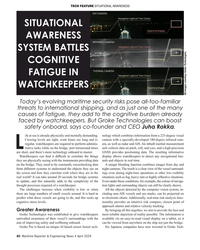 )
April 2024 - Maritime Reporter and Engineering News page: 40
)
April 2024 - Maritime Reporter and Engineering News page: 40TECH FEATURE SITUATIONAL AWARENESS SITUATIONAL AWARENESS SYSTEM BATTLES COGNITIVE FATIGUE IN WATCHKEEPERS All images courtesy Groke Technologies Today’s evolving maritime security risks pose all-too-familiar threats to international shipping, and as just one of the many causes of fatigue, they add
-
 )
April 2024 - Maritime Reporter and Engineering News page: 38
)
April 2024 - Maritime Reporter and Engineering News page: 38Tech Files Latest Products, Systems and Ship Designs Zero-Emission Mooring Service of a Tanker Consulmar achieved a milestone by executing what it calls ing boat Castalia, which operates on full electric propulsion. the world's ? rst zero-emissions mooring service for a tanker. Equipped with two 150 kW
-
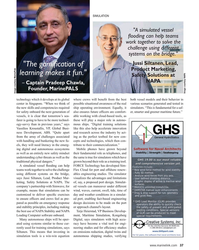 )
April 2024 - Maritime Reporter and Engineering News page: 37
)
April 2024 - Maritime Reporter and Engineering News page: 37SIMULATION "A simulated vessel ? ooding can help teams work together to solve the challenge using different systems on the bridge." – Jussi Siltanen, Lead, "The gami? cation of Product Marketing, learning makes it fun." Safety Solutions at NAPA – Captain Pradeep Chawla, Founder, MarinePALS Image
-
 )
April 2024 - Maritime Reporter and Engineering News page: 35
)
April 2024 - Maritime Reporter and Engineering News page: 35SIMULATION e have a close relationship with tech- Realism is prized beyond immersive, photo-realistic visu- nology, evidenced by, for example, als, and providers are introducing increasingly accurate func- the phones we are estimated to un- tionality. FORCE Technology’s upcoming DEN-Mark2 math- lock around
-
 )
April 2024 - Maritime Reporter and Engineering News page: 27
)
April 2024 - Maritime Reporter and Engineering News page: 27RADM PHILIP SOBECK, MILITARY SEALIFT COMMAND With COVID, we had to make some hard choices for our Do your CIVMARs have upward mobility? mariners because we couldn’t rotate. Many of our mariners The Navy has Sailors who become “Mustangs,” and work found other employment, and were able to use their skills
-
 )
April 2024 - Maritime Reporter and Engineering News page: 26
)
April 2024 - Maritime Reporter and Engineering News page: 26, 12 new classes of ships will come online and MSC will see up to 20 new ships deliver to the ? eet in the next ? ve years. This includes new oilers, towing, salvage and rescue tugs, and expeditionary fast transports and emergency medical ships. A large percentage of our ships are 40 years old or older
-
 )
April 2024 - Maritime Reporter and Engineering News page: 25
)
April 2024 - Maritime Reporter and Engineering News page: 25ve years. This includes new oil- Our Combat Logistics Force (CLF) is the key to keep- ing our ships at sea and in the ? ght, and sustain our forces ers, towing, salvage and rescue tugs, and expeditionary fast transports and emergency medical ships. A large percent- engaged in distributed maritime operations
-
 )
April 2024 - Maritime Reporter and Engineering News page: 21
)
April 2024 - Maritime Reporter and Engineering News page: 21ROB LANGFORD, VP, GLOBAL OFFSHORE WIND ob Langford has worked in the offshore industry ABS. “We are growing and evolving our services across all for more than three decades, ‘cutting his teeth’ offshore infrastructure along with our continued support to the in a UK design ? rm working in the North Sea
-
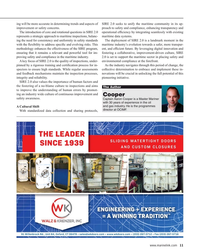 )
April 2024 - Maritime Reporter and Engineering News page: 11
)
April 2024 - Maritime Reporter and Engineering News page: 11ing will be more accurate in determining trends and aspects of SIRE 2.0 seeks to unify the maritime community in its ap- improvement or safety concerns. proach to safety and compliance, enhancing transparency and The introduction of core and rotational questions in SIRE 2.0 operational ef? ciency by
-
 )
April 2024 - Maritime Reporter and Engineering News page: 10
)
April 2024 - Maritime Reporter and Engineering News page: 10Maritime Safety © Roman/AdobeStock SIRE 2.0: Navigating the New Horizon of Maritime Safety By Captain Aaron Cooper, Programs Director, OCIMF he maritime industry is on the cusp of a signi? cant preparing vessel operators and vessel assurance teams for the transformation with the launch of the Ship
-
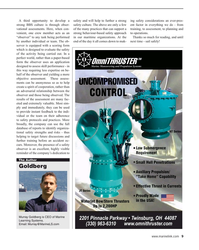 )
April 2024 - Maritime Reporter and Engineering News page: 9
)
April 2024 - Maritime Reporter and Engineering News page: 9A third opportunity to develop a safety and will help to further a strong ing safety considerations an ever-pres- strong BBS culture is through obser- safety culture. The above are only a few ent factor in everything we do - from vational assessments. Here, when con- of the many practices that can
-
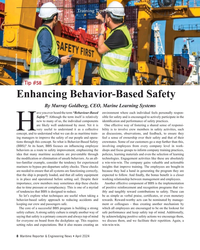 )
April 2024 - Maritime Reporter and Engineering News page: 8
)
April 2024 - Maritime Reporter and Engineering News page: 8Training Tips for Ships © By tuastockphoto/AdobeStock Tip #58 Enhancing Behavior-Based Safety By Murray Goldberg, CEO, Marine Learning Systems ave you ever heard the term “Behaviour-Based environment where each individual feels personally respon- Safety”? Although the term itself is relatively sible for
-
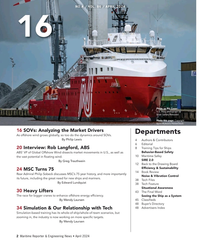 )
April 2024 - Maritime Reporter and Engineering News page: 2
)
April 2024 - Maritime Reporter and Engineering News page: 2NO.4 / VOL. 86 / APRIL 2024 16 Photo on the Cover: U.S. Navy photograph by Brian Suriani/Released Photo this page: Copyright Björn Wylezich/AdobeStock 16 SOVs: Analyzing the Market Drivers Departments As offshore wind grows globally, so too do the dynamics around SOVs. By Philip Lewis 4 Authors & Contribut
-
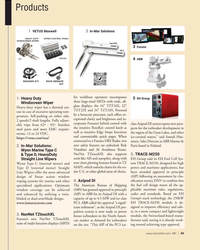 )
April 2024 - Marine News page: 43
)
April 2024 - Marine News page: 43Products 1 2 VETUS Maxwell In-Mar Solutions 3 Furuno ABB 4 for workboat operators encompasses EH Group 1. Heavy Duty 5 three large-sized MFDs with wide, all- Windscreen Wiper glass displays: the 16” TZT16X, 22” Heavy-duty wiper has a thermal cut- TZT22X and 24” TZT24X. Powered out in
-
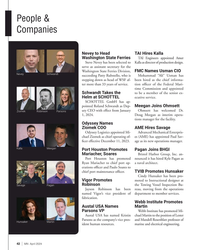 )
April 2024 - Marine News page: 42
)
April 2024 - Marine News page: 42to chief port maintenance of? cer. TVIB Promotes Hunsaker Cindy Hunsaker has been pro- moted to Instructional designer at Vigor Promotes Robinson the Towing Vessel Inspection Bu- Savage Pagan Jayson Robinson has been reau, moving from the operations named Vigor’s vice president of department to member
